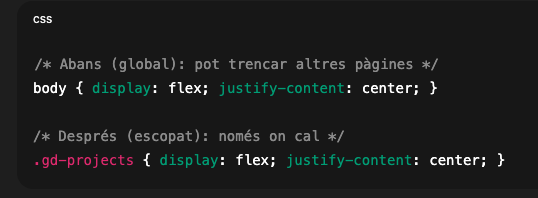To scope CSS styles means to limit their effect to a specific container instead of applying them globally. This practice prevents unintended side effects (such as an entire site switching layout or color scheme) and improves maintainability, accessibility, and visual consistency.
Example of CSS scoping
Before (global style)
/* Global: may break other pages */
body { display:flex; justify-content:center; }
After (scoped style)
/* Scoped: only affects the container */
.gd-projects { display:flex; justify-content:center; }
In HTML

With this pattern, the styles only apply inside .gd-projects.
Best practices for scoping styles
- Prefix with a container class (e.g. .gd-…) or use a namespace for each section.
- Avoid styling global tags (body, html, h1, a) outside a container.
- Use CSS variables at container level if you need local color schemes:

Prefer
:where()to reduce specificity and keep overrides simple:Avoid using
!importantunless strictly necessary.
Common mistakes
Applying global styles that overwrite backgrounds or text colors for the entire site.
Changing the body layout (flex/grid) globally.
Adding overlays or opacity filters that make all content look faded.
Enforcing global light/dark schemes instead of scoping them to a container.
Related concepts
Encapsulation of styles (Shadow DOM)
CSS Modules and CSS-in-JS
Specificity and cascade in CSS
Naming methodologies: BEM, ITCSS, namespaces
(Link these to other glossary entries if available.)
FAQ
When should you scope styles?
When a section or component needs its own styles (e.g., a portfolio, landing page, or embedded widget), or when sharing components across different pages.
Is scoping better than using !important?
Yes. Scoping is cleaner and easier to maintain. !important often causes specificity issues and should be a last resort.
How does scoping differ from Shadow DOM?
Shadow DOM provides native style encapsulation for web components. Scoping with classes is the traditional CSS approach.

